Glaucoma is a disease that damages the optic nerve and is a leading cause of blindness in the United States. Most loss of vision from glaucoma is preventable if the disease is treated early enough.
Glaucoma is known as the silent thief of vision for good reasons. Over 90% of people with glaucoma may have no signs or symptoms because the peripheral (side) vision is usually lost first.
Central vision (the part of the vision that we use on a daily basis) is affected much later. This means that blind spots can form just outside the central vision and grow larger and darker to affect large portions of the field of vision.
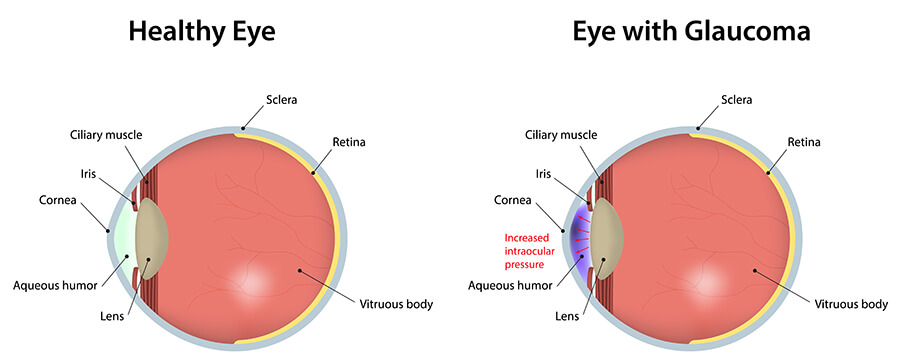
Many people are unaware they are losing vision until the central vision is affected. At this point, less than 20% of their vision may remain. This loss of vision can frequently be prevented by a simple test for glaucoma that is routinely performed as part of a complete eye examination.
Glaucoma is a leading cause of blindness in adults in the world; by one estimate, nearly 68 million persons worldwide have glaucoma, with almost 7 million becoming blind in both eyes. Unfortunately, nearly 50% of people with glaucoma may go undetected until they have lost substantial vision.
The risk of glaucoma increases as people get older. The estimated percent of the US population over 65 is expected to more than double within the next few years, and the number of new glaucoma cases is expected to increase as a result.
Risk Factors
Some people have a higher than average risk of developing glaucoma. For these patients, it is especially important to have thorough eye examinations every 1-2 years.
- Patients over the age of 40
- African-American or Caribbean blacks; Hispanics, or Asian patients
- Elevated eye pressure
- History of eye injury or multiple eye surgeries
- Family history of glaucoma
- Hyperopia or high myopia (extreme farsightedness or nearsightedness)
- Diabetes
- Corneal thickness less than 0.5mm
Prevention of Glaucoma
Early detection, appropriate treatment, and regular follow-up appointments are the best means of preventing loss of vision from glaucoma.
It is critical for everyone over the age of 40 to have a regular medical eye evaluation, including a glaucoma check that evaluates eye pressure and the condition of the optic nerve.
Many cases of glaucoma may take years to show signs of vision loss. The goal in Ophthalmology is to detect glaucoma at the earliest stage so that appropriate medical and surgical therapy may prevent visual loss.
Diagnosis of Glaucoma
There are three important factors in the diagnosis of glaucoma:
Intraocular Pressure (the pressure inside the eye)
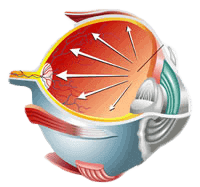 The eye normally creates fluid to keep the structures inside the eye healthy. This fluid creates pressure, which is called intraocular pressure. Some eyes require a lower pressure than others to remain healthy.
The eye normally creates fluid to keep the structures inside the eye healthy. This fluid creates pressure, which is called intraocular pressure. Some eyes require a lower pressure than others to remain healthy.
In the case of open-angle glaucoma, eye pressure builds up slowly over many months or even years.
Glaucoma can also occur with normal eye pressure. There is generally no pain, redness, or blurred vision.
In the early and middle stages, patients may not realize that they have glaucoma unless they receive regular eye examinations.
Optic Nerve Condition
The physician will also check the condition of the optic nerve, looking for the telltale signs of paleness and indentation that may indicate glaucoma.
Once vision is lost due to optic nerve damage, it cannot be restored. Current glaucoma treatments aim to stop or slow further loss of vision by reducing pressure.
Visual Field
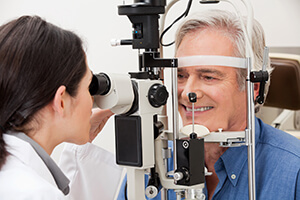 Typical early vision loss caused by glaucoma begins in the side) vision(also called peripheral vision. A large amount of side vision can be lost before the patient notices.
Typical early vision loss caused by glaucoma begins in the side) vision(also called peripheral vision. A large amount of side vision can be lost before the patient notices.
By this stage, glaucoma may be very advanced, and it may be difficult to prevent further vision loss. A careful visual field examination may well identify loss of peripheral vision before the patient notices, allowing early treatment of glaucoma.
How is Glaucoma tested?
In addition to a routine eye examination, your doctor’s team may perform several special tests:
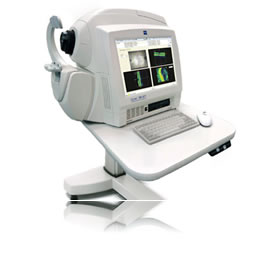
- Tonometry – is a test that is designed to measure the pressure inside the eye or intraocular pressure. There are several different types of tonometry.
- Gonioscopy – a painless exam that looks at the angle between the iris and the cornea in order to evaluate the fluid drainage system.
- Visual Fields Testing – this assesses the horizontal and vertical range and sensitivity of your vision. Patients are asked to push a button when they see lights flashing in their field of vision.
- Pachymetry – this measures the thickness of the cornea by using sound waves. Having thin corneas is a known risk factor for glaucoma.
- Optical Coherence Tomography (OCT) is an imaging technique that is similar to ultrasound imaging, except that light rather than sound waves are used to create images. It is a non-invasive, painless scan of the eye which takes 5 to 10 minutes. OCT can be used to assess optic nerve damage or disease progression. For further information on OCT, which was developed at New England Eye Center, please click this link.
Types of Glaucoma
Glaucoma is a disease in which eye pressure causes damage to the optic nerve. Located in the back of the eye, the optic nerve sends signals from the eye to the brain.
When it is damaged, the eye can no longer send signals to the brain. This leads to an irreversible loss of vision. The reasons why eye pressure causes damage to the optic nerve are still not clearly understood and are being actively investigated.
There are two primary types of glaucoma, open-angle, and angle-closure:
Open-angle glaucoma is by far the most common type of glaucoma and is either inherited or develops with age. The patient rarely notices the symptoms with open-angle glaucoma until the disease is an advanced stage.
Unfortunately, by this point in the disease, a patient may have irreplaceably lost a large portion of their visual field.
A complete eye examination can detect glaucoma in its early stages. This should include checking the eye pressure, observing the optic nerve, and another possible testing such as visual fields or OCT.
Angle-closure glaucoma can be due to many different causes. All causes result in a sudden blockage of the drainage system in the front part of the eye. This can cause a rapid rise in eye pressure, producing dramatic symptoms in the patient.
Symptoms of acute angle-closure include:
- Severe headache on the side of the involved eye.
- Halos around lights.
- Nausea and vomiting.
- Redness in the eye, which can be mistaken for conjunctivitis.
- Blurred vision in the affected eye.
Urgent Treatment Needed for Angle Closure Glaucoma
Patients with these symptoms should seek prompt medical attention in order to save as much sight as possible in the affected eye.
The exact treatment may depend on the primary cause of the blocked drainage system. A laser surgical procedure is frequently required to restore the normal fluid drainage in the eye.
Secondary Glaucoma
Some glaucomas are caused by other health issues or external events, such as trauma to the eye. Often they only affect one eye.
Treatments vary depending on the cause. Some examples of secondary glaucoma are:
- Growth of new blood vessels that block drainage. These neovascular glaucomas are often caused by a circulatory problem which results in a lack of blood flow to the carotid artery or the retina.
- Eye injuries can cause temporary or permanent damage which affects eye pressure.
- Inflammation of the eye (uveitis) or treatment of inflammation with steroids.
- Inflammatory diseases such as juvenile rheumatoid arthritis.
Congenital Glaucoma
This occurs in infants who are born with a malformation in the eye drainage canals. It can be successfully treated with medications and surgery.
Juvenile Glaucoma
This is a form of primary open-angle glaucoma that occurs in people from ages ten to thirty-five. It is a rare condition that has a strong genetic component.
Treatment of Glaucoma
 It is important to understand that glaucoma cannot be cured, but it can usually be controlled. With proper treatment over 90% of patients can have their disease stabilized and less than 5 % will lose all vision.
It is important to understand that glaucoma cannot be cured, but it can usually be controlled. With proper treatment over 90% of patients can have their disease stabilized and less than 5 % will lose all vision.
Currently, the only way that doctors know how to prevent further loss of vision from glaucoma is by lowering the pressure within the eye. This can be achieved by several primary methods: medical treatment, laser treatment, and surgical treatment.
Medical Treatment of Glaucoma
Eye drops and pills are the most common treatment for glaucoma. Taken regularly, they can be very effective in lowering eye pressure.
Some medications cause the eye to make less fluid, and others help fluid drain from the eye.
- There are several classes of medications used to treat glaucoma, and each has its own advantages and possible side effects. Your ophthalmologist will help you make an informed decision on the treatment that is best for you.
- Many of the medications used to treat glaucoma are powerful drugs. It is important that a certified health care provider prescribe these medications.
- Beta-blockers have been used to treat glaucoma for many years, and are the same type of medication that has been used for the treatment of high blood pressure. Unfortunately, they may cause complications with patients who have heart and lung problems.
Difficulty with Medical Treatment Approach
Because glaucoma often has no symptoms, patients may forget to use their drops or decide they are not important. Medications are only effective if taken regularly as directed by the eye care professional.
Side Effects
While most patients have no problems, some medications can cause side effects such as headaches, stinging, burning, or redness in the eyes.
Patients should tell their doctor if they are having problems with medication. There are many medicines available to treat glaucoma, and treatment with a lower dose or new medication may be possible.
Laser Treatment of Glaucoma
For more than 30 years, laser trabeculoplasty has been shown to be effective in the treatment of glaucoma. This procedure helps drain fluid out of the eye.
Usually, one eye is treated at a time. When laser treatments are needed for both eyes, they are generally scheduled several days or even weeks apart.
What Happens During the Laser Procedure?
Laser trabeculoplasty is performed in the eye clinic or your doctor’s office. Numbing drops are applied to the eye so that patients will not feel discomfort or pain. The doctor will hold a special lens to the eye.
An intense beam of light is aimed through the lens. Patients may see flashes of green or red light. The laser applies energy to the drainage area, which in turn allows the fluid to drain better.
Side Effects
Laser treatment may cause side effects such as inflammation. The patient may be given some eye drops to treat any soreness or inflammation.
Follow-Up
Many patients who undergo laser surgery must still continue to take their eye drops after the procedure. Sometimes the effects of the treatment can wear off over time.
It is therefore important that patients continue to have routine eye examinations after laser surgery.
Acute angle-closure glaucoma can sometimes be prevented with a laser that creates holes in the iris. This procedure can normally be accomplished in the office with the use of topical anesthesia.
Following placement of a special contact lens on the eye, the doctor creates a new opening in the iris with one or two lasers, and then the patient is sent home with eye drops to use following the surgery.
Surgical Treatment of Glaucoma
Surgical treatment for glaucoma involves creating a new path for the fluid to flow from the eye back to the body. This can be effective in lowering the pressure within the eye. Normally this is reserved for patients who have a poor response to eye drops and/or laser surgery.
This can sometimes be combined with another eye operation, like cataract surgery. Surgical treatments are performed in an operating room, either at a hospital outpatient surgery area or in a local ambulatory eye surgical center.
Glaucoma surgery includes all of the risks involved with any eye surgery. Your ophthalmologist can explain the risks and benefits of this treatment.
How does surgery work?
There are two primary ways of creating a new path for the fluid (also known as aqueous humor) to drain from the eye. One requires the surgeon to create a new drain in the eye called trabeculectomy, and the second method involves implanting a glaucoma drainage device.
The choice of which technique to use is determined by many factors, including the type of glaucoma the patient has, and the number of previous surgeries on the eye.
-
- Trabeculectomy surgery requires the surgeon to create a tiny hole in the eye. The surgeon also creates a small flap in the white of the eye (called the sclera) to loosely cover this hole. After surgery, a small bubble known as a filtration bleb forms under the upper eyelid. The fluid in the eye can then drain out through the flap into the bleb. The fluid is absorbed by the tissue around the eye and goes back into the eye.
Implantation of a glaucoma drainage device – In this procedure, the surgeon places a small drainage tube into the eye.
This tube is connected to a reservoir, which is placed on the white part of the eye under the eyelid. The fluid drains through the drainage tube into the reservoir, where it is absorbed into nearby blood vessels.
Micro-invasive glaucoma surgery (MIGS)
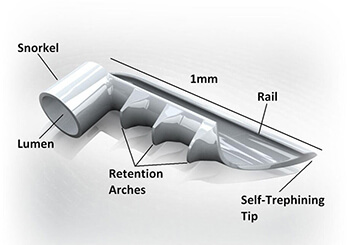
iStent
For some patients, generally those with early to moderate glaucoma, there is another type of surgery that may be recommended, called micro-invasive glaucoma surgery (MIGS). Generally, these procedures carry less risk than traditional glaucoma surgery.
The glaucoma doctors at New England Eye Center are experienced with a wide array of these MIGS procedures and will discuss whether one may be appropriate for your case.
MIGS procedures offered at New England Eye Center include:
- iStent
- Cypass
- Kahook Dual Blade goniotomy
- Endoscopic Cyclophotocoagulation (ECP)
- Micropulse Cyclophotocoagulation
- XEN Gel Stent
